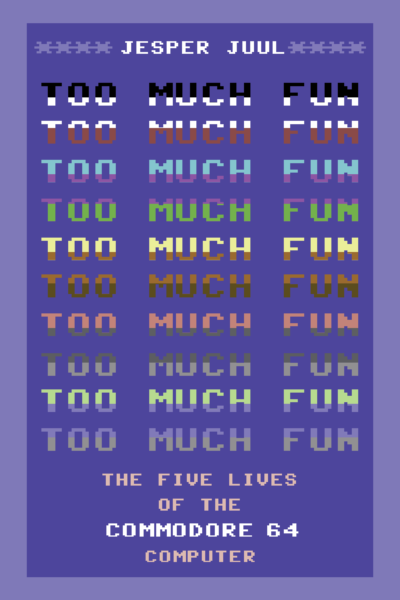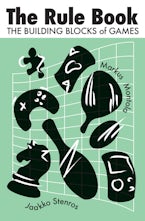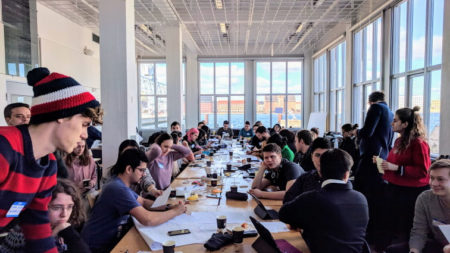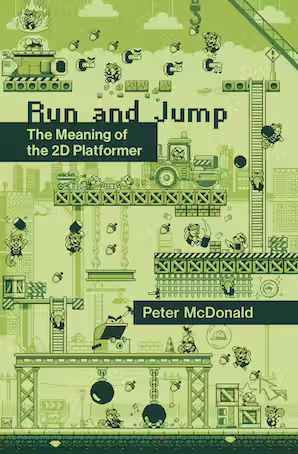And we have a cover for my upcoming book (December 10th, 2024). https://mitpress.mit.edu/9780262549516/too-much-fun/

My name is Jesper Juul, and I am a Ludologist [researcher of the design, meaning, culture, and politics of games]. This is my blog on game research and other important things.
And we have a cover for my upcoming book (December 10th, 2024). https://mitpress.mit.edu/9780262549516/too-much-fun/

I am happy to announce that I have finished the page proofs for my new book, Too Much Fun: The Five Lives of the Commodore 64 Computer. Coming on December 10th, 2024. Feel free to preorder!
I will post more as we get closer to the publication date.
https://mitpress.mit.edu/9780262549516/too-much-fun/

 Presenting The Rule Book: The Building Blocks of Games by Jaakko Stenros and Markus Montola. Out now on MIT Press in the Playful Thinking series.
Presenting The Rule Book: The Building Blocks of Games by Jaakko Stenros and Markus Montola. Out now on MIT Press in the Playful Thinking series.
How games are built on the foundations of rules, and how rules—of which there are only five kinds—really work.
Board games to sports, digital games to party games, gambling to role-playing games. They all share one thing in common: rules. Indeed, rules are the one and only thing game scholars agree is central to games. But what, in fact, are rules? In The Rule Book, Jaakko Stenros and Markus Montola explore how different kinds of rules work as building blocks of games. Rules are constraints placed on us while we play, carving a limited possibility space for us. They also inject meaning into our play: without rules there is no queen in chess, no ball in Pong, and no hole in one in golf.
Stenros and Montola discuss how rules constitute games through five foundational types: the explicit statements listed in the official rules, the private limitations and goals players place on themselves, the social and cultural norms that guide gameplay, the external regulation the surrounding society places on playing, and the material embodiments of rules. Depending on the game, rules can be formal, internal, social, external, or material.
By considering the similarities and differences of wildly different games and rules within a shared theoretical framework, The Rule Book renders all games more legible.
 Please join us for our Visual Game & Media Design two-year master’s program in Copenhagen!
Please join us for our Visual Game & Media Design two-year master’s program in Copenhagen!
The application deadline is March 1st.
Read more about the program here:
https://royaldanishacademy.com/programme/visual-game-and-media-design

Out now in the Playful Thinking series: Peter D. McDonald: Run and Jump, The Meaning of the 2D Platformers.
We are proud to present Peter D. McDonald’s new book.
“How abstract design decisions in 2D platform games create rich worlds of meaning for players.
Since the 1980s, 2D platform games have captivated their audiences. Whether the player scrambles up the ladders in Donkey Kong or leaps atop an impossibly tall pipe in Super Mario Bros., this deceptively simple visual language has persisted in our cultural imagination of video games. In Run and Jump, Peter McDonald surveys the legacy of 2D platform games and examines how abstract and formal design choices have kept players playing. McDonald argues that there is a rich layer of meaning underneath, say, the quality of an avatar’s movement, the pacing and rhythm of level design, the personalities expressed by different enemies, and the emotion elicited by collecting a coin.
To understand these games, McDonald draws on technical discussions by game designers as well as theoretical work about the nature of signs from structuralist semiotics. Interspersed throughout are design exercises that show how critical interpretation can become a tool for game designers to communicate with their players. With examples drawn from over forty years of game history, and from games made by artists, hobbyists, iconic designers, and industry studios, Run and Jump presents a comprehensive—and engaging—vision of this slice of game history.”
We have an online open house for our 2-year Visual Game & Media Design Master’s Program at the Royal Danish Academy in Copenhagen.
Join us Tuesday January 30th at 14:30 Copenhagen time.
Details Here: https://kglakademi.dk/kalender/visual-game-and-media-design
For Handmade Pixels, I interviewed some really interesting people in indie games. The interviews are excerpted in the book, but I am slowly putting the full interviews online.
Handmade Pixels is about the history of (the idea of) indie games, and these 2017-2018 interviews provide a window into the thinking at the end of the 20-year time span the book covers.
Here is my interview with Sam Roberts, festival director of IndieCade, where we discuss IndieCade and film festivals, the meaning of indie, and the fear of missing the Next Big Thing.
https://www.jesperjuul.net/handmadepixels/interviews/roberts.html
20th Anniversary notes on The Game, the Player, the World: Looking for a Heart of Gameness.
What is a game? Early in my career, people wanted to know, but should I try to respond? In The Game, the Player, the World: Looking for a Heart of Gameness I tried to give an answer that was attentive to the ways we use the word “game”, open to change, and useful for generating new kinds of games. I presented the paper as a keynote talk at 2003 DiGRA conference in Utrecht, an early career highlight for me.
What is a game? Many people had already tried to answer the question and I had read many previous game definitions. Though I thought the paper was comprehensive, it turned out that I had overlooked writers like Celia Pearce and Clark C. Abt, but I felt that the previous definitions shared difficulties both in dealing with history and with the difference between games and other structured activities, such as going to the university.
What is a game? I wanted to answer this by examining points of contention about what we consider, or don’t consider, a game – that is, I made descriptive definition of how the category of games functions, rather than a static and prescriptive one.
Technically, I think the paper did three things that were different than previous attempts. (It is entirely possible that all makers of game definitions consider themselves unique.)
Reading the text again, it is striking that three terms have changed meaning during the intervening twenty years:
Telephone: A student asked me why the paper states that telephones aren’t used for playing games, since this seems to be common today. A good question, but at the time of writing, “telephone” meant a landline phone. We did have mobile phones and we played games on them, but not on landline “telephones”.
Hypertext fiction: In 2003, “Hypertext Fiction” referred to experimental literature such as Shelley Jackson’s Patchwork Girl. I discuss in Handmade Pixels how 1990s hypertext fiction writers felt it important that, to be taken seriously, their works were not considered games, and in this paper, I respect that and place them outside the classic game circle. Yet appearing during the 2010s, the genre of Twine games had some surface similarities to Hypertext Fiction, but were either structured as games, or referred to game conventions (sometimes by rejecting them). Though Twine games are sometimes also called “hypertext fiction”, I always argue that Twine games are games.
Game: Much experimental work eschewed the “game” label twenty years ago, perhaps because it sounded unserious, but today we have much more work that tries to make games into something new, and my original paper did fully not anticipate Modern Art-like strategies of working in the game tradition by strongly breaking with that tradition. I think experimental game work can exist in part because some of the stigma of “games” has disappeared, and while – as I note in the paper – games such as SimCity were originally not classed as game by the creator, there is now widespread agreement that a game can be an open-ended simulation that does not need to tell you what is good or bad (“valorization of outcomes”), and that game form can also serve to deliver fixed experience over which you have minimal control and responsibility as a player (“player attached to outcome”), as with the walking simulator genre. Game, or especially video game, can now stand for any audiovisual experience with player input.
I work from the assumption that it is easier to break the rules if you know them, so I expose students to conventions in different genres and ways to break them, so that students can decide how (and if) they want their games to be experimental.
How I use The Game, the Player, the World in teaching: I find the article useful for teaching, both to get students to see themselves as active thinkers about theory and games, and for creating new ideas:
The Game, The Player, the World taught me that it can be productive to examine fundamental questions, but often by providing different kinds of answers than expected.
[1] I think this was inspired by Todorov’s account of The Fantastic in literature.
PS. I still don’t think Wittgenstein said anything profound about games specifically (or about Spiele). I read him as making a much broader point – that we cannot assume that a given word has a clearly delineated meaning, which is clearly true. Unfortunately, he is usually invoked to avoid examining the complex meanings of a word, especially the word game.